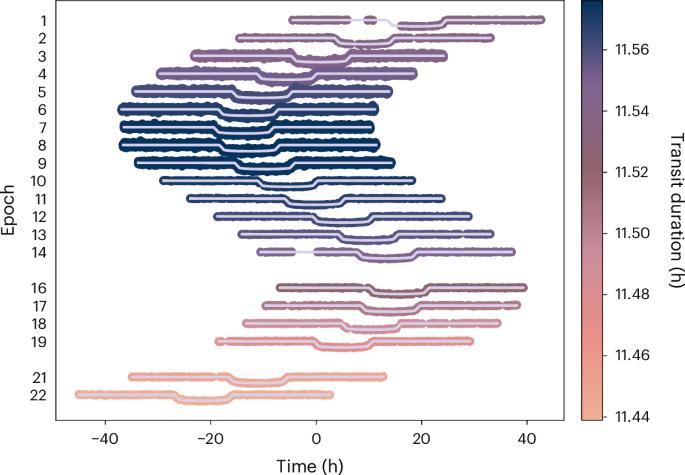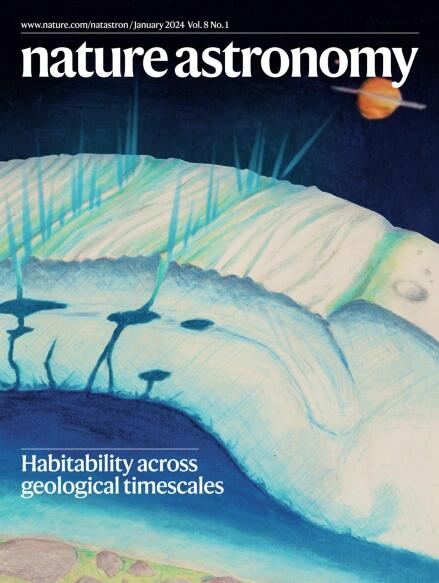A high mutual inclination system around KOI-134 revealed by transit timing variations
IF 14.3
1区 物理与天体物理
Q1 ASTRONOMY & ASTROPHYSICS
引用次数: 0
Abstract
Few planetary systems have measured mutual inclinations, and even fewer are found to be non-coplanar. Observing the gravitational interactions between exoplanets is an effective tool to detect non-transiting companions to transiting planets. Evidence of these interactions can manifest in the light curve through transit timing variations (TTVs) and transit duration variations (TDVs). Here, through analysis of Kepler photometry and joint TTV–TDV modelling, we confirm the detection of KOI-134 b, a transiting planet with mass and size similar to Jupiter on a period of ~67 days, and find that it exhibits high TTVs (20-h amplitude) and significant TDVs. We explain these signals with the presence of an innermost non-transiting planet in 2:1 resonance with KOI-134 b. KOI-134 c has a mass $$M=0.22{0}_{-0.011}^{+0.010}{M}_{{\rm{Jup}}}$$ and a moderately high mutual inclination with KOI-134 b of $${i}_{{\rm{mut}}}=15.{4}_{-2.5}^{+2.{8}^{\circ }}$$ . Moreover, the inclination variations of KOI-134 b are so large that the planet is predicted to stop transiting in about 100 years. This system architecture cannot be easily explained by any one formation mechanism, with other dynamical effects needed to excite the planets’ mutual inclination while still preserving their resonance. Using Kepler, this study identifies a compact multiplanetary system that is not flat, where gravitational interactions cause its planets’ periods to change by nearly a day per cycle and their orbital planes to tilt back and forth.

通过凌日时间变化揭示了KOI-134周围的高互倾角系统
很少有行星系统测量到相互倾斜度,发现非共面的就更少了。观测系外行星之间的引力相互作用是探测凌日行星非凌日伴星的有效工具。这些相互作用的证据可以通过凌日时间变化(TTVs)和凌日持续时间变化(TDVs)在光曲线中表现出来。本文通过开普勒光度法分析和联合TTV-TDV模型,我们证实了KOI-134 b这颗质量和大小与木星相似的凌日行星的探测周期为67天,并发现它具有较高的ttv (20 h振幅)和显著的tdv。我们用与KOI-134 b存在2:1共振的最内层非凌日行星来解释这些信号。KOI-134 c的质量为\(M=0.22{0}_{-0.011}^{+0.010}{M}_{{\rm{Jup}}}\),与KOI-134 b的相互倾角为\({i}_{{\rm{mut}}}=15.{4}_{-2.5}^{+2.{8}^{\circ }}\)。此外,KOI-134 b的倾角变化如此之大,以至于预计这颗行星将在大约100年后停止凌日。这种系统结构不能轻易地用任何一种形成机制来解释,需要其他的动力学效应来激发行星的相互倾斜,同时仍然保持它们的共振。
本文章由计算机程序翻译,如有差异,请以英文原文为准。
求助全文
约1分钟内获得全文
求助全文
来源期刊

Nature Astronomy
Physics and Astronomy-Astronomy and Astrophysics
CiteScore
19.50
自引率
2.80%
发文量
252
期刊介绍:
Nature Astronomy, the oldest science, has played a significant role in the history of Nature. Throughout the years, pioneering discoveries such as the first quasar, exoplanet, and understanding of spiral nebulae have been reported in the journal. With the introduction of Nature Astronomy, the field now receives expanded coverage, welcoming research in astronomy, astrophysics, and planetary science. The primary objective is to encourage closer collaboration among researchers in these related areas.
Similar to other journals under the Nature brand, Nature Astronomy boasts a devoted team of professional editors, ensuring fairness and rigorous peer-review processes. The journal maintains high standards in copy-editing and production, ensuring timely publication and editorial independence.
In addition to original research, Nature Astronomy publishes a wide range of content, including Comments, Reviews, News and Views, Features, and Correspondence. This diverse collection covers various disciplines within astronomy and includes contributions from a diverse range of voices.
 求助内容:
求助内容: 应助结果提醒方式:
应助结果提醒方式:


